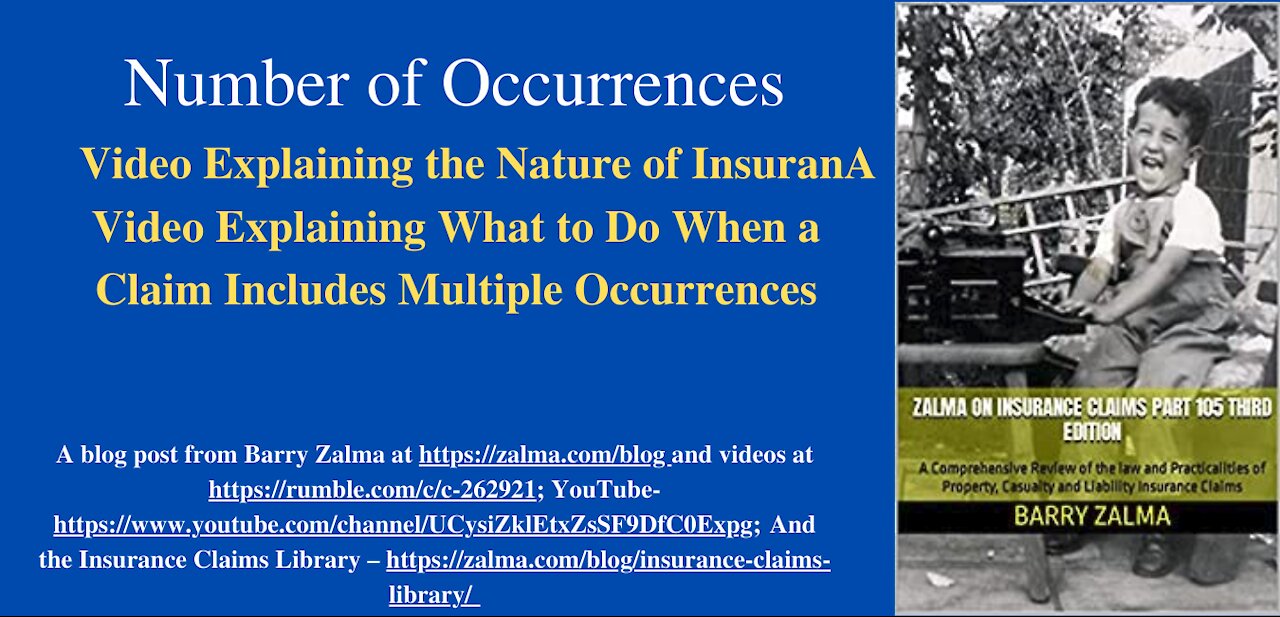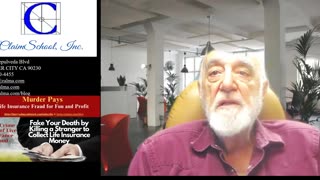Premium Only Content

A Video Explaining What to Do When a Claim Includes Multiple Occurrences
Number of Occurrences
CGL policies are written with endorsements that make the number of occurrences highly important, especially in continuing loss cases. deductibles or self-insured retentions are charged based on the number of occurrences or the number of claims. policy limits can apply individually per occurrence, individually per loss, individually per claim, or in the aggregate over a one year period. The test applied is usually objective. [Uniroyal, Inc. v. Home Insurance Company, 707 F. Supp. 1368 (1988); Champion International Corporation v. Continental Casualty Company, 546 F. 2d 502 (1976), Cargill, Inc. v. Liberty Mutual Insurance Company, 488 F. Supp. 49 (1979) Affirmed 621 F. 2d 275 (1980); Mason v. Home Insurance Company, 177 Ill. App. 3d 454, 532 N.E. 2d 526 (1988); 64 A.L.R. 4th 688.]
A triggering injury in fact for an underlying claim may be found as early as the time of first exposure to asbestos or silica, and may continue progressively through the claimant's death or the date of filing the claim, whichever occurs earlier. [Danaher Corp. v. Travelers Indem. Co., 414 F.Supp.3d 436 (S.D. N.Y. 2019)]
In Lombard v. Sewerage and Water Board of New Orleans, 284 So.2d 905 (La.1973) and its progeny, the courts in exposure cases have applied the “effect” test as opposed to the “cause” test in determining the number of [Thebault V. American Home, 2015-0800 (La. App. 4Cir. 4/20/16), 195 So. 3d 113.]
A common method of allocation is referred to as the "time on the risk" method, whereby each insurer is responsible for the pro rata percentage of time the insurer's policy was in effect over the course of the full time period over which loss was sustained by the insured. For example, Edison Co. Of New York, Inc. v. Allstate Ins. Co., 774 N.E.2d 687, 695 (N.Y. 2002)] affirmed the trial court allocation of loss through "time-on-the-risk" method, while "not foreclos[ing] pro rata allocation among insurers by other methods."
© 2021 – Barry Zalma
Barry Zalma, Esq., CFE, now limits his practice to service as an insurance consultant specializing in insurance coverage, insurance claims handling, insurance bad faith and insurance fraud almost equally for insurers and policyholders.
He also serves as an arbitrator or mediator for insurance related disputes. He practiced law in California for more than 44 years as an insurance coverage and claims handling lawyer and more than 54 years in the insurance business.
Subscribe to Excellence in Claims Handling at https://barryzalma.substack.com/welcome.
He is available at http://www.zalma.com and [email protected]. Mr. Zalma is the first recipient of the first annual Claims Magazine/ACE Legend Award. Over the last 53 years Barry Zalma has dedicated his life to insurance, insurance claims and the need to defeat insurance fraud. He has created the following library of books and other materials to make it possible for insurers and their claims staff to become insurance claims professionals.
Go to training available at https://claimschool.com; articles at https://zalma.substack.com, the podcast Zalma On Insurance at https://anchor.fm/barry-zalma; Follow Mr. Zalma on Twitter at https://twitter.com/bzalma; Go to Barry Zalma videos at https://www.rumble.com/zalma ; Go to Barry Zalma on YouTube- https://www.youtube.com/channel/UCysiZklEtxZsSF9DfC0Expg; Go to the Insurance Claims Library – https://zalma.com/blog/insurance-claims-library/ The last two issues of ZIFL are available at https://zalma.com/zalmas-insurance-fraud-letter-2/ podcast now available at https://podcasts.apple.com/us/podcast/zalma-on-insurance/id1509583809?uo=4
-
 13:02
13:02
Barry Zalma, Inc. on Insurance Law
1 year agoMurder Pays
4401 -
 18:48
18:48
Barry Zalma, Inc. on Insurance Law
4 years agoA Video Explaining Construction Experts
633 -
 19:42
19:42
Barry Zalma, Inc. on Insurance Law
4 years agoA Video Explaining Negotiation of Settlement of a First Party Property Claim
65 -
 16:24
16:24
Barry Zalma, Inc. on Insurance Law
4 years agoA Video Explaining the Construction Contract
107 -
 LIVE
LIVE
freecastle
10 hours agoTAKE UP YOUR CROSS- THANKSGIVING MUSIC EXTRAVAGANZA!
81 watching -
 57:54
57:54
A Cigar Hustlers Podcast Every Day
6 hours agoCigar Hustlers Podcast Evere Week Day w/Steve Saka
4.92K1 -
 1:09:06
1:09:06
Mike Mac - Say Something
17 hours agoSAY SOMETHING w/ MIKE MAC
3.31K -
 30:15
30:15
DeVory Darkins
11 hours agoTrump drops NIGHTMARE NEWS for Afghan refugees after National Guard Shooter is identified
149K181 -
 LIVE
LIVE
Lofi Girl
3 years agolofi hip hop radio 📚 - beats to relax/study to
272 watching -
 23:47
23:47
James Klüg
1 day agoAnti-Trumpers SNAP When I Arrive
32K37